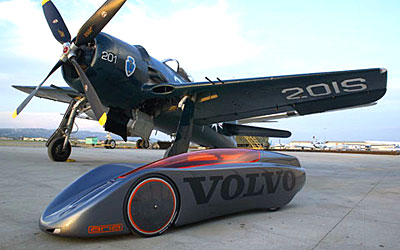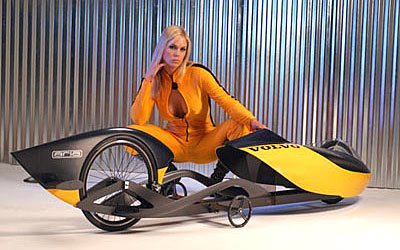Extreme Gravity Car!
:: The Volvo "Aria" won the grand prize in the extreme gravity competition by designing a car, without a motor, that reached a top speed of 54 mph!
++ Auto Tech: USA / Don MacAllister / Extreme Gravity Racing (EGR)
Extreme gravity racing is a high-tech, high-speed version of the quintessentially grassroots soapbox derby, a slice of Americana that has fascinated kids for the past seven decades.
 Conceptually, not much has changed since the first event was staged in 1934: Build a small, simple race car according to tightly constrained rules, and coast down a racetrack powered by nothing more complicated than gravity. However, a lot has changed in the design of the cars, as evidenced by Volvo's "Aria", the car that won the latest extreme gravity car race!
Conceptually, not much has changed since the first event was staged in 1934: Build a small, simple race car according to tightly constrained rules, and coast down a racetrack powered by nothing more complicated than gravity. However, a lot has changed in the design of the cars, as evidenced by Volvo's "Aria", the car that won the latest extreme gravity car race!
“We paired a cost-effective fiberglass body with a steel-frame chassis and space-age high performance ceramic components, orchestrated with the latest sophisticated computer modeling and test techniques, yielding a design that reflects and harnesses Volvo’s brand and Scandinavian soul.” ~Blair Taylor, Volvo Designer, and leader of the Volvo Monitoring and Concept Center (VMCC) team.
 The Extreme Gravity Competition, was founded by Don MacAllister of America Works for Kids. Their way of helping foster kids is to provide as many job opportunities for them as possible during the extreme gravity races. This helps support the foster kids transition from the foster care system to become working, self-sufficient members of the community!
The Extreme Gravity Competition, was founded by Don MacAllister of America Works for Kids. Their way of helping foster kids is to provide as many job opportunities for them as possible during the extreme gravity races. This helps support the foster kids transition from the foster care system to become working, self-sufficient members of the community!“We were very happy with how the kids were able to contribute to the Monterey race,” said MacAllister. “It would have been very difficult to carry out the race without the hard work of our foster kids. I look forward to their involvement in the upcoming Irvine race.”
 Volvo won the grand prize for design in its first attempt (2004) to build a gravity car. It was constructed from lightweight materials such as aluminium, carbon-fibre and fibreglass giving it an "anorexic" weight of just 15 kgs. Every inch of this car was optimised for aerodynamic performance, and to decrease rolling resistance. The rider lies face down inside cramped bodywork with their head just behind the front wheel, steering is controlled by handlebars attached directly to the front axle, and braking is done by a trigger on the left handlebar. This car tops out at around 40 mph.
Volvo won the grand prize for design in its first attempt (2004) to build a gravity car. It was constructed from lightweight materials such as aluminium, carbon-fibre and fibreglass giving it an "anorexic" weight of just 15 kgs. Every inch of this car was optimised for aerodynamic performance, and to decrease rolling resistance. The rider lies face down inside cramped bodywork with their head just behind the front wheel, steering is controlled by handlebars attached directly to the front axle, and braking is done by a trigger on the left handlebar. This car tops out at around 40 mph.Note From Technophile: Aerodynamically optimized, engine-less cars (built by engineers and stylists at nine automobile manufacturers) race wheel-to-wheel, while hurtling down intimidating curves, essentially turning extreme gravity racing into a mini "Formula One". As in a traditional soapbox derby competition, gravity still rules, but the materials, fabrication techniques and costs have moved into the 21st century. Computer-aided design and carbon-fiber components are commonplace, and engineers are experimenting with demon tweaks ranging from formula-car suspensions to tires that are integrated into the wheels. Several teams used computational-fluid-dynamics programs to shape the futuristic bodywork. Some even tested their cars in wind tunnels!:: Source: [Gravity Series, Inc.]
:: Image Credits: Gravity Series, Inc.
:: Innovation: Designing and building gravity powered cars that can travel at incredible speeds!
:: Available: Now.
:: Cost: $100,000 for design and development. $30,000 (donation) to purchase.
"To finish first, you must first finish." ~Rick Mears




















1 Comments:
Now lets race together all of us gather up everything that has no fuel and gravity is our only means of horse power.
Post a Comment
<< Home